On View
Hauser and Wirth Teams Up with Steve Martin on a Love Letter to Los Angeles
The gallery's homage to the city of angels in art and cinema centers on Steve Martin's classic 1991 film 'L.A. Story.'
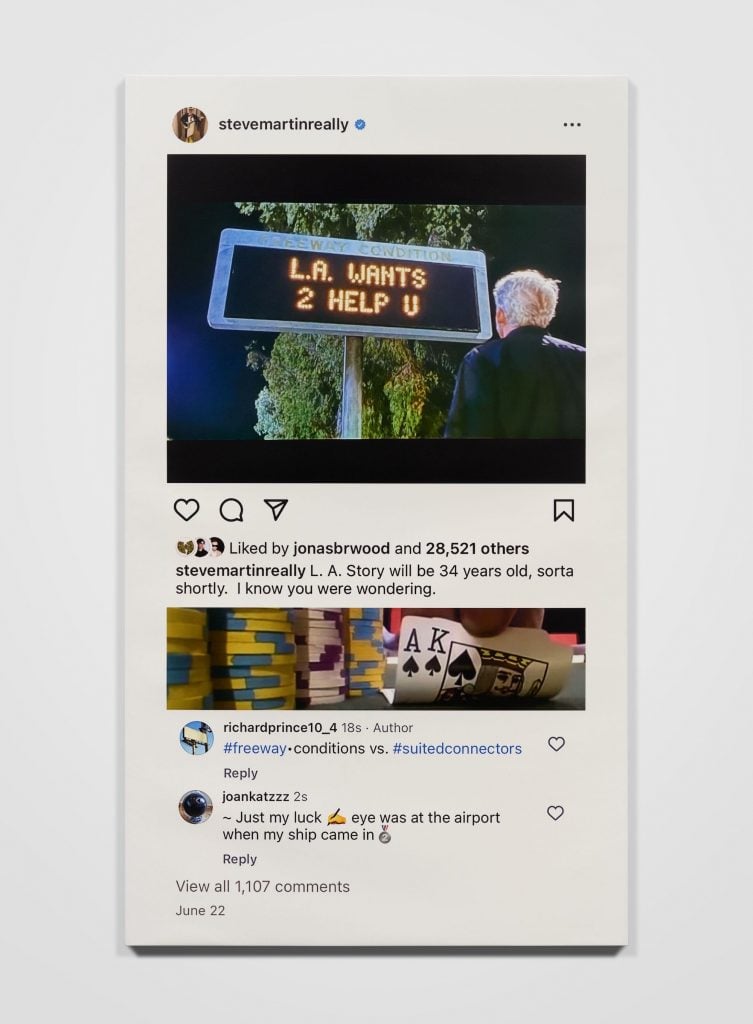
The gallery's homage to the city of angels in art and cinema centers on Steve Martin's classic 1991 film 'L.A. Story.'

Eileen Kinsella

Just in time for the sweeping, Getty-organized PST Art initiative taking place this fall in Los Angeles, mega-gallery Hauser and Wirth is unveiling its own love letter to the city of angels with a show at its West Hollywood space inspired by a film classic and the passion of a top local collector.
It’s none other than the beloved 1991 film L.A. Story, written by and starring Steve Martin, which delves into the city’s familiar tropes and hallmarks: cerulean swimming pools and epic sunsets juxtaposed with the perils of earthquakes, endless traffic on sprawling freeways, and, of course, no shortage of pretentious, self-involved characters. And don’t forget the cutthroat competition for reservations at trendy if unimaginably condescending restaurants.
That scenario was the backdrop for the central character, Harris K. Telemacher, the so-called “Wacky Weatherman” who simultaneously searches for the meaning of life (or at least a deeper one) and pursues true love in a city that’s allegedly and notoriously devoid of culture.
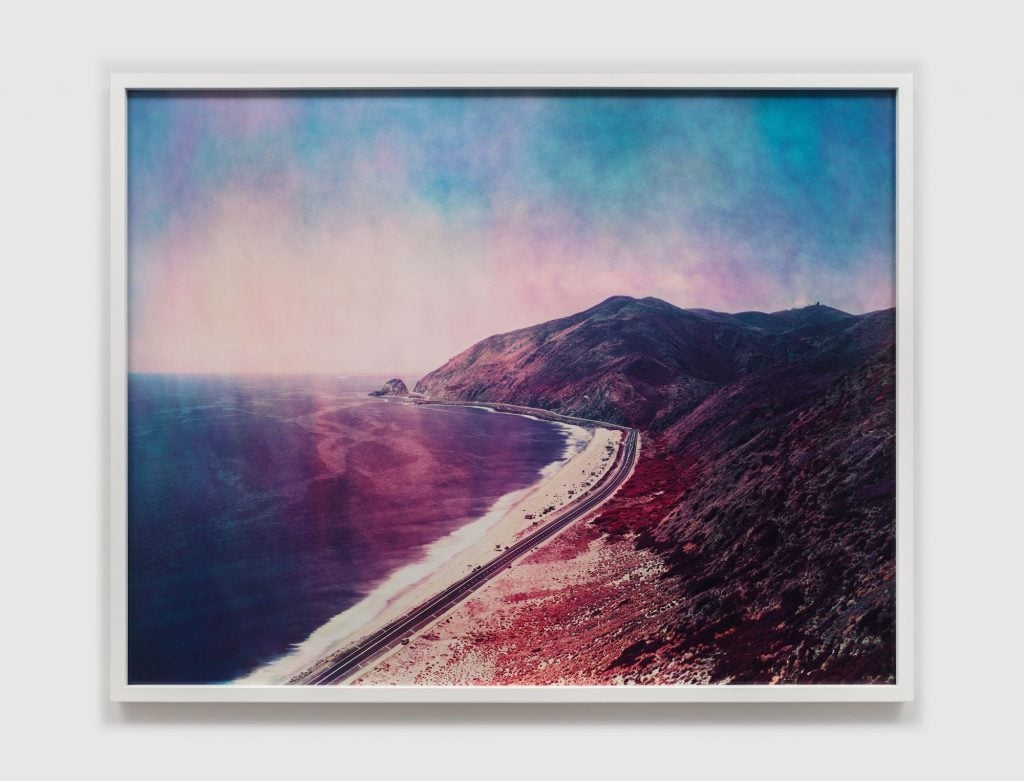
Florian Maier-Aichen, Untitled (2023). © Florian Maier-Aichen. Courtesy of the artist and BLUM Los Angeles, Tokyo, New York Photo: Justin Craun.
“I had the idea in my head for about a year,” said Mike Davis, senior director of the gallery, in an interview. “It would pop up in conversation with artists. It’s one of these cultural touchstones that would come up at dinner parties like, ‘Oh that scene in L.A. Story where there’s an earthquakes and no one blinks.’”
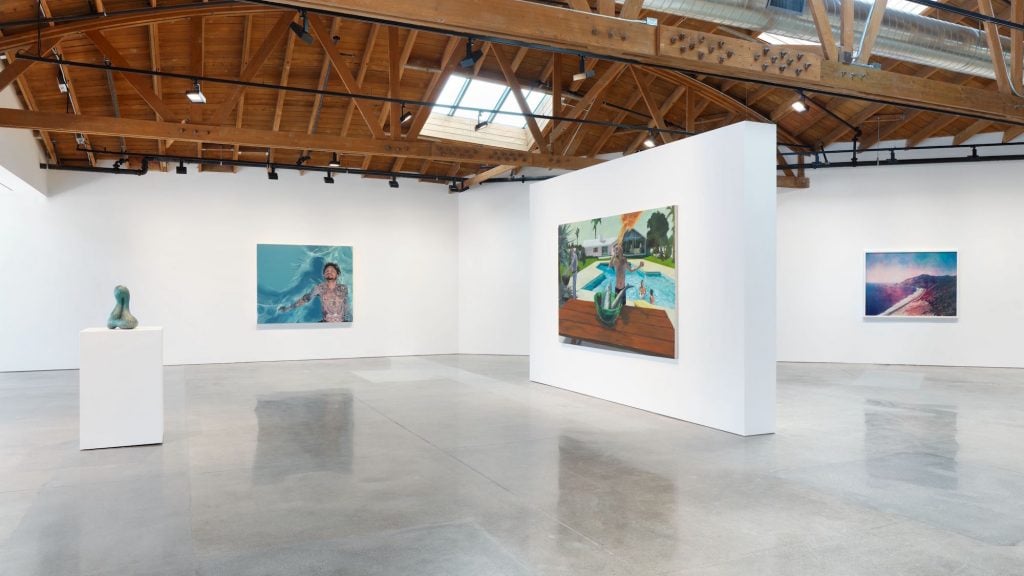
Installation view, “‘L.A. Story,” at Hauser & Wirth West Hollywood.
Image courtesy the artists and Hauser & Wirth
Photo: Paul Salveson
Davis and Ingrid Schaffner, senior curatorial director, co-organized the show “in dialogue” with Martin, as per the gallery. The cross-generational lineup of artists includes Mark Bradford, Vija Celmins, Eric Fischl, David Hockney, Luchita Hurtado, Friedrich Kunath, Florian Maier-Aichen, Hilary Pecis, Calida Rawles, Jennifer Rochlin, and Ed Ruscha.
Though Martin was unable to co-curate because of a busy schedule (Only Murders In the Building, anyone?), he has been “phenomenal the whole way,” said Davis.
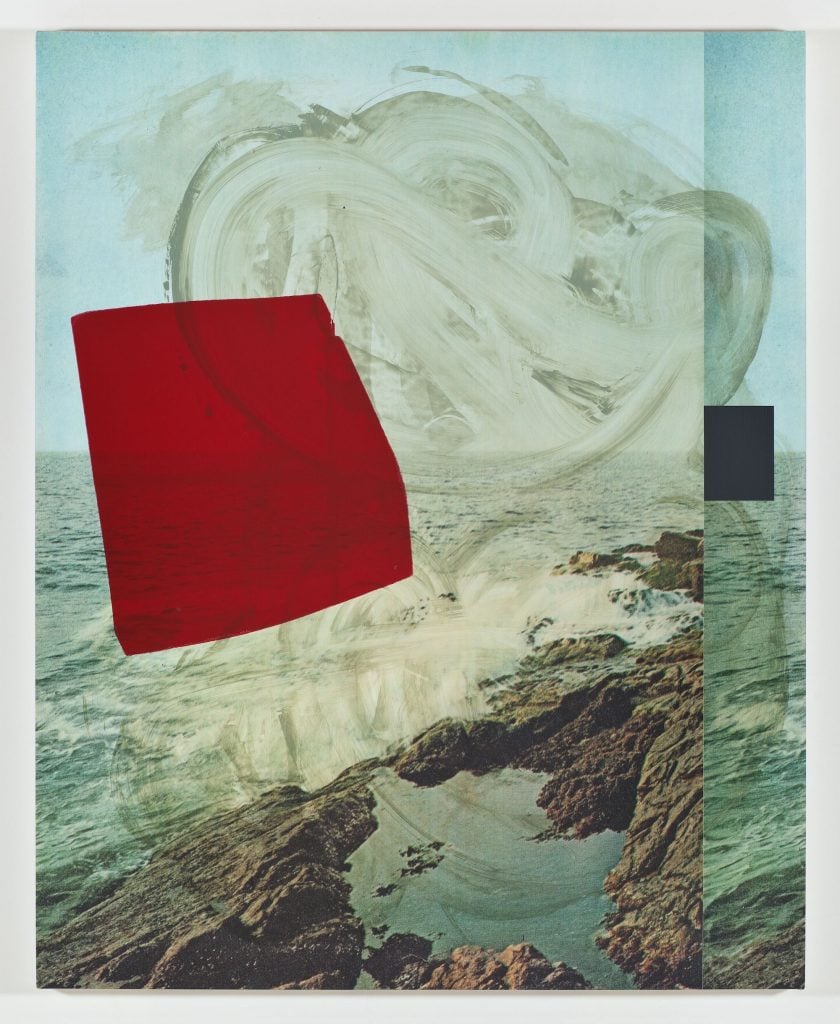
Kevin Appel, Screen (ocean) (2011). © Kevin Appel. Image courtesy the artist and Hauser and Wirth. Photo: Brian Forrest.
“One of the reasons that we really wanted to get his point of view is because in the film he’s talking about L.A. as being culturally vacuous, but he’s an incredibly astute and sophisticated collector. He educates himself and is a repository of knowledge,” said Davis.
“He has been collecting since [the days when] it was not the art hub that it is today,” Davis added. “We wanted to get his opinion firsthand about how it has shifted.”
Davis started working in L.A. galleries around 2009. “It was right around the pivot point at which L.A. collectors started buying work by L.A. artists from L.A. galleries,” he said. “Prior to that, and Steve confirmed this, the L.A. collectors used to go to New York to buy L.A. artists from New York galleries. It was like they almost needed the New York stamp of approval. L.A. aspired to be this art hub but it wasn’t there yet. It started to become that, and has continued to where we’re at today.”
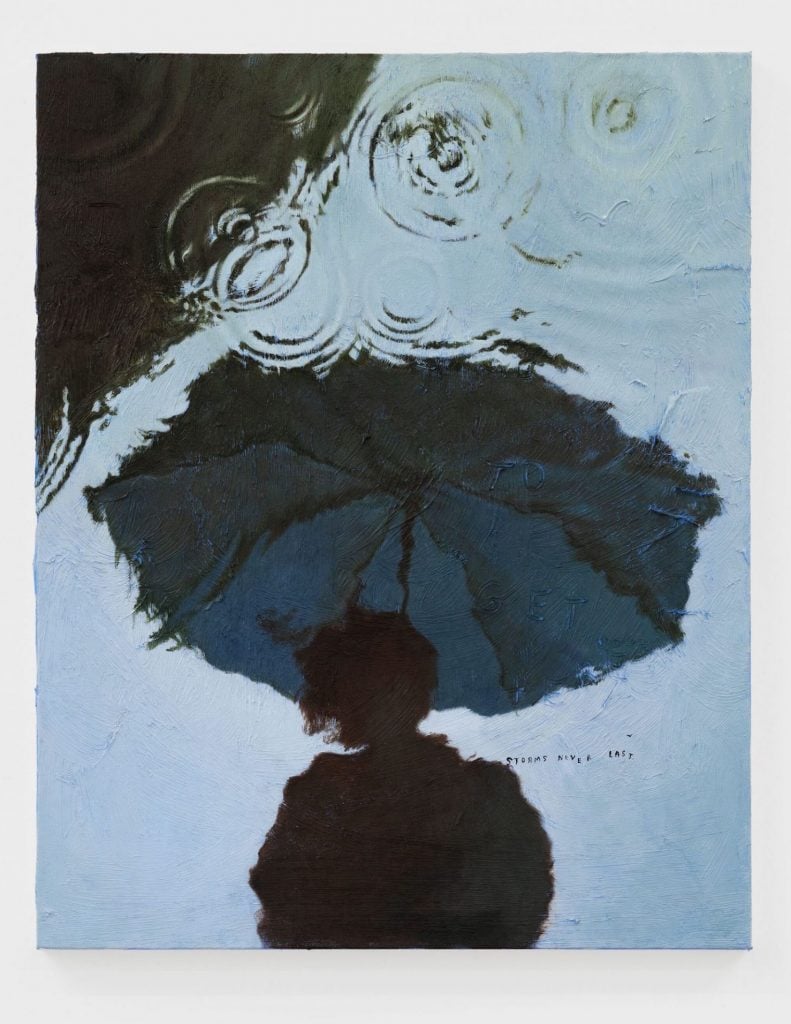
Friedrich Kunath, Storms Never Last (study) (2023). © Friedrich Kunath. Image courtesy Friedrich Kunath and Studio FK, Inc. Photo: Dawn Blackman.
The conversations among the three have clearly been fruitful. When Martin mentioned that he still had the original bound script with his annotations, said Schaffner, “We’re like ‘Oh, we want that!’” The script will be on view, opened to a particular page. “That’s how we’re going to bring in the moment in the film where Martin, as Harris Telemacher, is holding forth in front of an abstract red color field painting at LACMA and talking about a puppy and a woman’s blouse and it’s all these things that you can’t see in the picture.”
Appearing nearby will be Allen Ruppersberg’s self-published Greetings From LA (1972), which bills itself as a novel but is mostly blank pages.
It’s threads like this that Davis and Schaffner hope to use to counter the notion that L.A. has been devoid of culture throughout its history. “It’s like, ‘Hello, isn’t cinema and movie-making culture?” asks Schaffner. “In the ’60s and ’70s you had all these artists who were happily living adjacent to Hollywood and cinema and making works that are often quite cinematic in their own ways.”
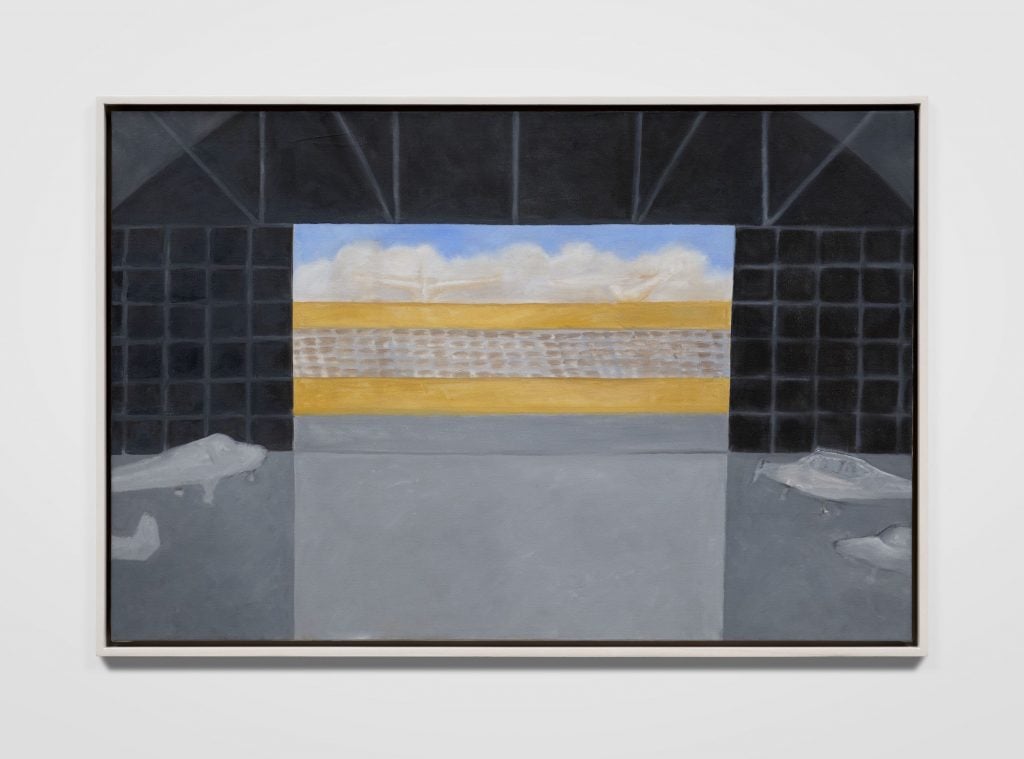
Luchita Hurtado, Untitled (circa 1990). © The Estate of Luchita Hurtado. Courtesy the Estate of Luchita Hurtado and Hauser and Wirth. Photo: Keith Lubow.
The film opens with a giant hot dog floating across the sky above sunbathers and loungers at a party. The exhibition opens with a related theme via paintings that feature quintessentially Californian backyard swimming pools by Hockney, Fischl and Rawles. (That hot dog, the historic prop for the famous Tail O’ the Pup hot dog stand, now located on Santa Monica Boulevard, will be the site of the post-opening reception.)
“We begin with pools,” said Davis. “It’s actually very exciting to see the Hockney in conversation with Calida Rawles. And then we move to highways, freeways, and landscape with the Ruscha and the Bradford, and then we come into the cultural space. Those great scenes in the movie that take place at LACMA, that’s where abstraction comes in.”
A piece by Hurtado, who passed away in 2020 at the age of 99, is part of a series centered on the Santa Monica airport. It’s meant to evoke one of the final scenes of the movie, where extreme inclement weather fortuitously grounds the plane on which Telemacher’s love interest is set to leave the country.
One of the “secret delights” that emerged during research for the show, said Schaffner, was when Martin revealed that the scene was inspired by a traditional Irish ballad in which a man wills the wind to rebuff the ship on which the love of his life has just departed.
While Martin has loaned three works to the show, it will also include a commissioned work from Richard Prince based on a Martin Instagram post showing an iconic scene in which Telemacher gazes up at a talking roadside sign that throughout the film offers him guidance on his love life.
Over the course of many conversations with Martin, as well as in doing their own due diligence, Davis says he and Schaffner also found that some figures who are known as New York artists who actually had their formative time in L.A. “Richard Prince exhibited a number of his early ‘joke’ paintings close to the gallery, in a tear-down bungalow presented by Regen Projects,” said Davis.
Schaffner noted a late 1990s headline from art critic Christopher Knight at a time when he wrote that L.A. had not written its history yet and compared it with cities that had done so, such as Berlin. Said Schaffner: “We are coming on this moment of Pacific Standard Time. Well, L.A. has been writing its history. There is this whole new L.A. story, and that’s also one of the many narratives of our exhibition.”
“L.A. Story” opens at Hauser and Wirth in West Hollywood on September 12 and runs through January 4, 2025.